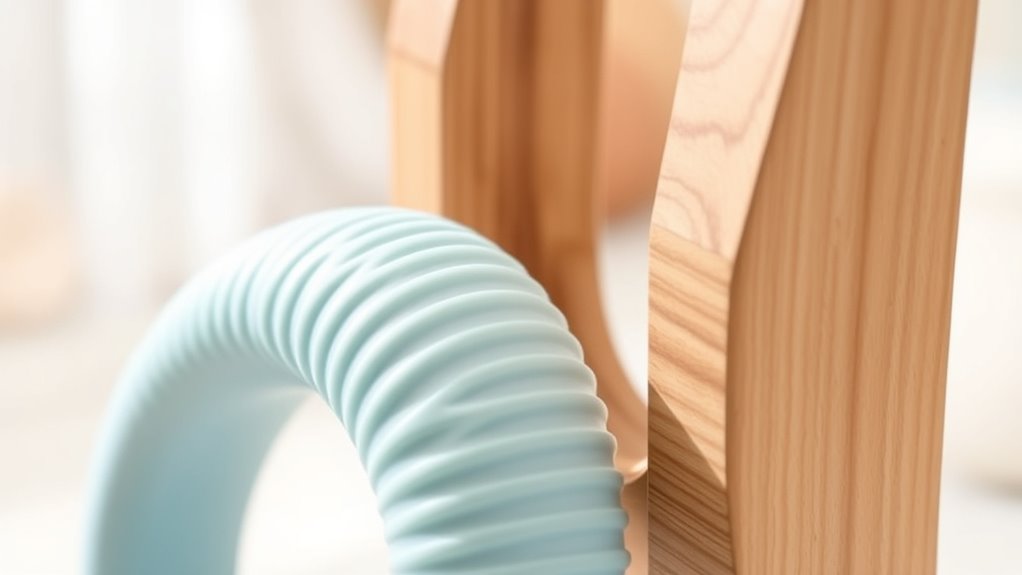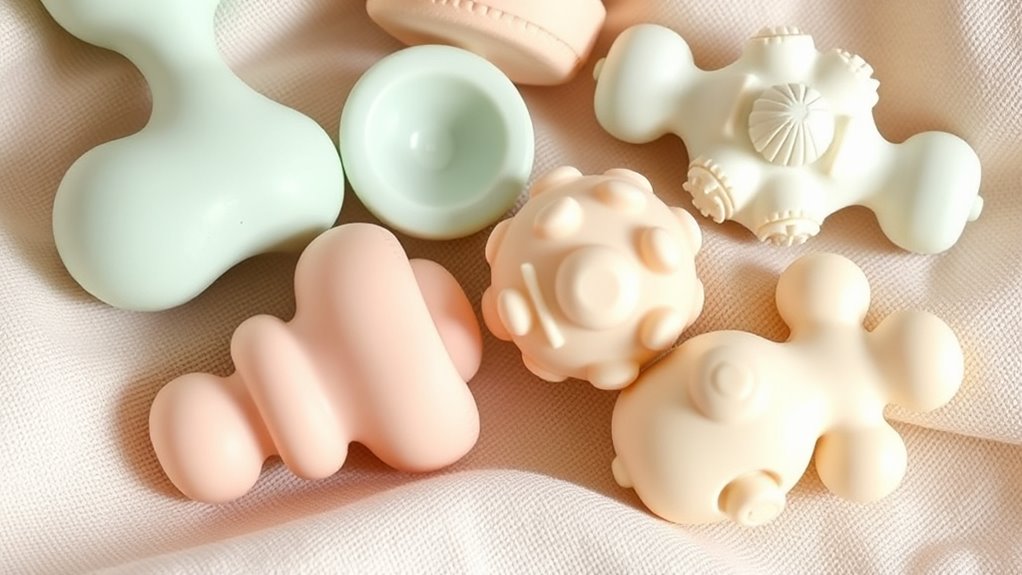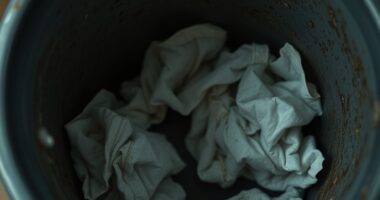When choosing safe teething toys, focus on those made from non-toxic, food-grade silicone or natural rubber, and verify they’re BPA- and phthalate-free. Look for designs that fit comfortably in tiny hands and feature textured surfaces to soothe gums while being easy to clean. Avoid toys with small parts or sharp edges that could pose risks. If you want to know how to select the best options for your baby, continue exploring the key safety factors involved.
Key Takeaways
- Choose toys made from BPA-free, phthalate-free, food-grade silicone, or natural rubber to ensure safety and non-toxicity.
- Opt for ergonomic designs with textured surfaces that fit comfortably in small hands and provide gum relief.
- Ensure toys have smooth, rounded edges without small parts or loose components to prevent choking hazards.
- Select easy-to-clean toys that are dishwasher-safe or wipeable to maintain hygiene and prevent bacterial buildup.
- Regularly inspect teething toys for wear or damage to keep materials intact and safe for continued use.

Are you wondering how to soothe your teething baby? One of the most vital factors to consider is choosing teething toys made from safe, high-quality materials. You want to guarantee that the toys you give your little one won’t expose them to harmful chemicals. Chemical safety should be your top priority; look for products labeled BPA-free, phthalate-free, and free from any other potentially toxic substances. Many manufacturers now highlight their commitment to safety by using non-toxic, food-grade silicone or natural rubber. These materials are not only safe but also soft enough to soothe sore gums without causing discomfort. Avoid toys made from cheap plastics or painted surfaces that might chip or contain dangerous chemicals. Remember, babies tend to chew vigorously, so selecting materials with chemical safety in mind helps prevent accidental ingestion of harmful substances. Regularly inspecting teething toys for signs of wear or damage is essential to maintain safety and prevent potential choking hazards.
Another vital aspect is the ergonomic design of teething toys. You want a toy that fits comfortably in your baby’s hand, allowing for easy grasping and maneuvering. An ergonomic design ensures the toy’s shape and size are appropriate for tiny hands, reducing frustration and encouraging independent exploration. Look for textured surfaces or different ridges, which can provide extra relief to sore gums and stimulate sensory development. A well-designed teether won’t be too heavy or awkward to hold, and it should have some flexibility to adapt to your baby’s biting pressure without breaking or causing injury. Some toys come with multiple textures or attached teething rings, which can help target different areas of the gums and offer versatile relief. Incorporating safe, non-toxic materials into the design further enhances overall safety and peace of mind for parents.
When choosing a teething toy, think about how the design promotes safety. Avoid toys with small parts or loose components that could pose a choking hazard. Ensure the toy’s surface is smooth and free from sharp edges or rough spots that might scratch or irritate your baby’s delicate skin. Additionally, many ergonomic toys are designed to be easy to clean, which is essential for maintaining good hygiene and preventing bacterial buildup. A simple wipe-down or dishwasher-safe feature makes daily cleaning straightforward, reducing the risk of germs.
Frequently Asked Questions
Are Natural Materials Always Safer Than Synthetic Ones?
Natural materials aren’t always safer than synthetic ones, but they often offer natural alternatives that reduce chemical exposure. When choosing teething toys, you should consider synthetic safety by checking for non-toxic, BPA-free labels. It’s essential to evaluate each material’s safety, as some natural options might contain allergens, while some synthetics are specially designed to be safe. Always prioritize quality and expert recommendations over assumptions about natural versus synthetic.
How Do I Identify Non-Toxic Dyes and Paints?
Think of yourself as a detective, Sherlock Holmes style, searching for clues on how to identify non-toxic dyes and safe paint. Look for labels that specify “food-grade” or “baby-safe.” Check for certifications like ASTM or FDA approval. When shopping, choose products with natural or vegetable-based dyes. Always ask suppliers about non-toxic dyes and safe paint identification, ensuring your teething toys are truly safe for your little one.
Can Teething Toys Be Reused After Sterilization?
Yes, teething toys can be reused after sterilization, but you need to follow proper sterilization methods to guarantee reuse safety. You can boil them, use a sterilizer, or dishwasher with a sanitize cycle, depending on the toy’s material. Always check the manufacturer’s instructions first. Proper sterilization removes germs and keeps your baby safe, allowing you to reuse teething toys confidently.
What Age Range Are These Teething Toys Suitable For?
Ever wonder when your little one is ready for teething toys? These toys are generally suitable from 3 months up to 12 months, aligning with infant developmental stages and teething milestones. During this time, your baby explores and soothes their gums. Always choose age-appropriate, safe teething toys to support their growth. Are you ready to help your baby comfortably navigate this exciting phase?
How Long Should a Teething Toy Last Before Replacing?
You should replace a teething toy when it shows signs of wear or damage, which affects its durability expectations. Typically, the replacement frequency depends on how often your child uses it and the toy’s quality. Regularly inspect for cracks or tears, and if you notice any, it’s time for a new one. Prioritize safety by ensuring your child’s teething toys remain intact and effective for soothing.
Conclusion
Choosing safe teething toys is vital for your baby’s health and comfort. Focus on non-toxic materials and thoughtful design to prevent choking and allergic reactions. Did you know that over 30% of teething toys tested contained harmful chemicals? By selecting toys made from safe, BPA-free, and natural materials, you can guarantee your little one’s teething experience is both safe and soothing. Always check for quality and safety labels to keep your baby happy and healthy.









